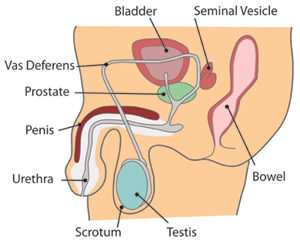The human reproductive system
This page has been written to help with the basic understanding of the human reproductive system to help clarify issues that may cause infertility and the potential procedures the Fertility Centre may utilise to aid conception.
The female reproductive system
The reproductive system, fertilisation and menstrual cycle.
The diagram below shows the major components of the female reproductive system. The vagina which leads to the cervix (neck of the womb), the uterus (womb) and the fallopian tubes (the site of fertilisation) which lead to the ovaries.

When a woman ovulates (releases an egg) the egg is picked up by the end of the fallopian tube (the fimbria) and sits inside the tube awaiting fertilisation.
When a man and a woman have intercourse sperm are deposited at the neck of the womb where they swim into the mucus. The sperm then swim up into the womb and eventually into the fallopian tubes where they meet the egg. When one sperm binds with the egg, fertilisation takes place. The genetic information (DNA) which the sperm and egg both carry join together and the fertilised egg (now known as a zygote) begins to divide to form an embryo which is the beginning of life.
The embryo then travels down the fallopian tube for 3-4 days and into the womb (uterus). When it reaches the womb it attaches to the lining (endometrium). This is called implantation. The embryo receives all its nutrients (food) from the mother through the lining of the womb.
The menstrual cycle
If fertilisation does not occur, the corpus luteum (what is left of the follicle) degenerates (gets smaller) and stops producing progesterone. This means that the lining of the womb is no longer being stimulated and begins to come away from the wall of the womb. This causes some bleeding and the result is the menstrual period. This happens about every 28 days in most women but can vary considerably; it is commonly referred to as ‘coming on’ or ‘having a period’. The usual range of normal menstrual cycles is 21 to 35 days.
The first day of a period is usually referred to during treatment as day one of the cycle. An average woman ovulates about 14 days after the start of her last period. It is important that women realise they are only able to conceive (get pregnant) for two or three days around the time of ovulation (the release of the egg). Except when certain drug combinations are used for Intra Uterine Insemination (IUI), Donor Intra-Uterine Insemination (DIUI), In-Vitro Fertilisation (IVF) & Intra-Cytoplasmin Sperm Injection Treatment (ICSI)
The male reproductive cycle
Men start to produce sperm at puberty and most continue to do so for their entire life. Sperm are produced in specialised areas of the testicle known as ‘seminiferous tubules’, taking about 8 weeks to reach maturity. When they are mature they are released and transported to the ‘epididymis’ where they are further matured prior to being ejaculated during intercourse.
At the time of ejaculation, the sperm are transported through the ‘vas deferens’ and fluid is added to the sperm from various glands, including the prostate and seminal vesicles during their journey. This mixture of secretions is known as semen.
The human sperm’s only function is to transport the man’s genetic information (DNA) through the female reproductive tract to the egg. Once the sperm reaches the egg in the fallopian tube (of the 150 million or so that are ejaculated only a few dozen complete the journey) it penetrates the egg by releasing enzymes and fertilises the egg, creating a zygote.

